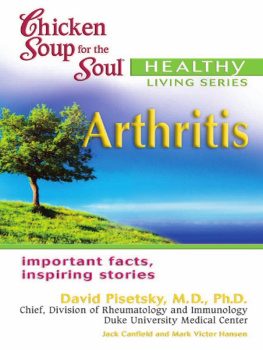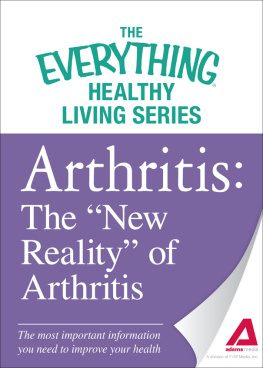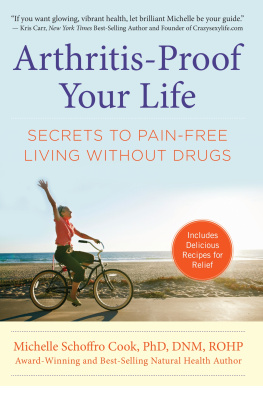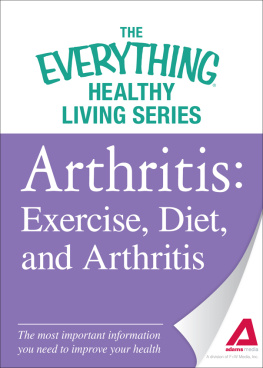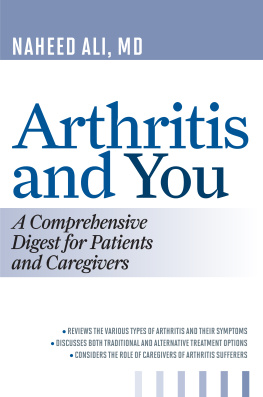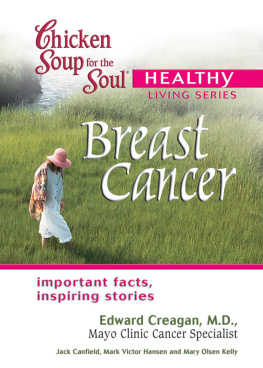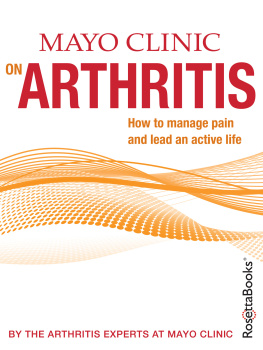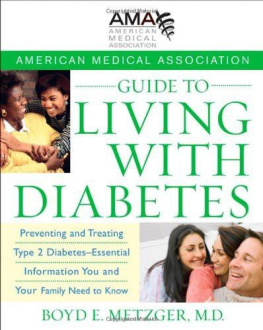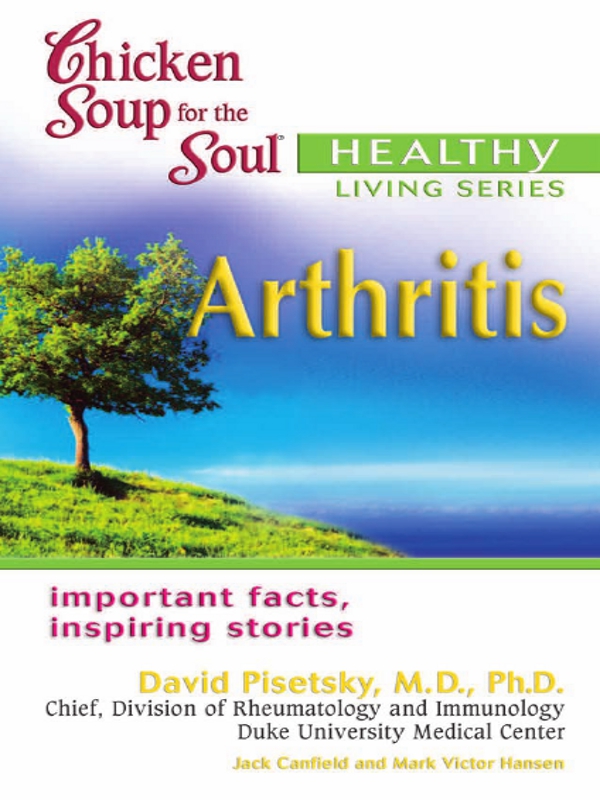
Chicken Soup for the Soul
Healthy Living:
Arthritis
Chicken Soup for the Soul
Healthy Living:
Arthritis
Jack Canfield
Mark Victor Hansen
David Pisetsky, M.D., Ph.D.
CHIEF, DIVISION OF RHEUMATOLOGY AND IMMUNOLOGY
DUKE UNIVERSITY MEDICAL CENTER

Health Communications, Inc.
Deerfield Beach, Florida
www.hcibooks.com
www.chickensoup.com
Library of Congress Cataloging-in-Publication Data
is available from the Library of Congress
2006 Jack Canfield and Mark Victor Hansen
eISBN 13: 978-0-7573-9904-6 eISBN 10: 0-7573-9904-5
All rights reserved. Printed in the United States of America. No part of this publication may be reproduced, stored in a retrieval system or transmitted in any form or by any means, electronic, mechanical, photocopying, recording or otherwise, without the written permission of the publisher.
HCI, its Logos and Marks are trademarks of Health Communications, Inc.
Publisher: Health Communications, Inc.
3201 S.W. 15th Street
Deerfield Beach, FL 334428190
Cover design by Larissa Hise Henoch
Inside book design by Lawna Patterson Oldfield
Inside book formatting by Dawn Von Strolley Grove
Contents
Cindy La Ferle
Abha Iyengar
Linda Hanson
Eileen Valinoti, R.N.
Carolyn Dodge Adams
Pamela Jenkins
Lawrence D. Elliott
Fran McNabb
Arthritis is one of the most common of all medical conditions but nevertheless among the most misunderstood. This misunderstanding can have important consequences for patients: delay in seeking medical attention; utilization of unproven remedies; and an attitude of discouragement, believing that arthritis is inevitable and untreatable. In writing this book, my hope has been to clear up some of this confusion and to describe the new approaches to therapy that can be of great benefit.
When I see a new patient with arthritis in my clinic, one of my very main priorities is to provide education about this condition. First, I explain what arthritis is and emphasize that there are over one hundred different diseases that have arthritis as a part. Next, I outline to the patient a plan for diagnosis. Sometimes, establishing a diagnosis is not easy because the same symptomsjoint pain and swellingare common to all one hundred of the different diseases. Nevertheless, with a complete history and physical exam and selected X-ray and blood tests, I usually have a good idea of the diagnosis.
With a clear diagnosis, my next job is to explain to the patient the treatment options so that together we can develop a treatment plan that is right for their arthritis. The past decade has witnessed a revolution in treatment of rheumatoid arthritis, with five new and more effective drugs approved for use in this disease. The development of a single drug for a disease is remarkable. The development of five in this short period of time is unprecedented, and, indeed, can be called miraculous. With these new drugs, the outcome of treatment promises to be even brighter as physicians are raising their expectations as they strive to not only reduce symptoms of disease but even induce remission.
Not everyone with arthritis has rheumatoid arthritis. In fact, most have a condition called degenerative arthritis or osteoarthritis. For this disease, progress in treatment has also been impressive but, for osteoarthritis, the developments have been in the realm of surgery not medication. Joint replacement remains one of the most successful and beneficial of all types of surgery, with new techniques allowing replacement joints that function well for decades. I forever marvel as patients (as well as friends and family) undergo a transformation after joint replacement surgery as they switch from discouraged, tired and hurting people into vibrant and energetic people who are anxious to get on with life and enjoy activity pain-free.
This book bolsters what I as a physician can do in the clinic and provides information for how to live better with arthritis. Whatever the form of arthritis, pain is present. A physician can do only so much to reduce pain. The rest must come from the patient. Hopefully, this book will provide you with guidance, understanding and information to take charge of your disease and work better with your physician to live as happy and pain-free a life as possible.
David Pisetsky, M.D., Ph.D.

S everal years ago, when I was diagnosed with severe osteoarthritis in both hips, I read every book, magazine and medical pamphlet I could find about coping with chronic illness. I was amazed at how often Id stumble on a paragraph that advised patients to look for the gift in your pain.
Pain is a gift? Thanks, but no thanks, Id mutter to myself. I had just turned forty-four and hadnt planned on slowing down so soon. I still had miles to go with my journalism career and a family that included a very active teenager. If pain was my gift, well, where was the return policy? Within a year of my diagnosis, the disease progressed so quickly that total hip replacement surgery was my only option.
By that time, I was unable to walk without assistive devices. Even on a good day, it hurt so much to crawl out of bed that I refused to unplug my heating pad and leave the house. Suddenly I was certifiably disabledeven qualified for a handicapped parking permit. Having been fit and active most of my adult life, I was way too proud to let others watch me struggle on a walker. I hated to appear needy. I didnt want pity. So I started canceling lunch dates and appointments, and tried to hide behind a steely mask of self-sufficiency.
But my closest friends and family members didnt buy any of it. And it was through their patience and love that I finally discovered the gift in chronic illness: It slowly unravels your pride and opens you to the boundless generosity of other people.
Of course, stubborn self-reliance isnt the sole province of the disabled. Most women I know pride themselves on being nurturers, fixers, problem-solvers, givers. Well supply all the brownies for the bake sale at school after weve organized the rummage sale at church. Well rearrange our schedules to babysit other peoples kids. Just ask, and well triple our workload at the office and still make it to the evening PTA meeting. Yet some of us would rather have a wisdom tooth pulled than ask somebody else for a favor when we need it. As a girlfriend told me recently, Its my job to be the glue that holds everyone and everything together. I cant ask for help.
The truth is, people who care about us really do want to helpif only wed drop the facade of total self-reliance and admit that were not all-powerful all the time.
Discussing the aftermath of September 11 and the cleanup at Ground Zero, a talk show host suggested that if anything positive rose from the ashes of the tragedy, it was that America quickly evolved from a Me nation into a We nation. As she explained it, even the most self-absorbed among us realized that we cannot function as individual islands. We need each other. It was a good lesson for me to review so soon after my first hip replacement surgery. Strapped to a hospital bed and hooked to several tubes, including an IV, I was hit with the sobering reality that I wasnt going anywhere by myself.
And during the early weeks of my recovery, I had no choice but to graciously accept support from my family and friends. When my husband processed mountains of laundry at home, I tried not to feel guilty. When our neighbors sent casseroles or offered to drive my carpool shift to school, I swallowed my pride and allowed their care to work like a healing balm. And it did. As hard as it was to surrender, I discovered theres real strength in vulnerability.
Next page
